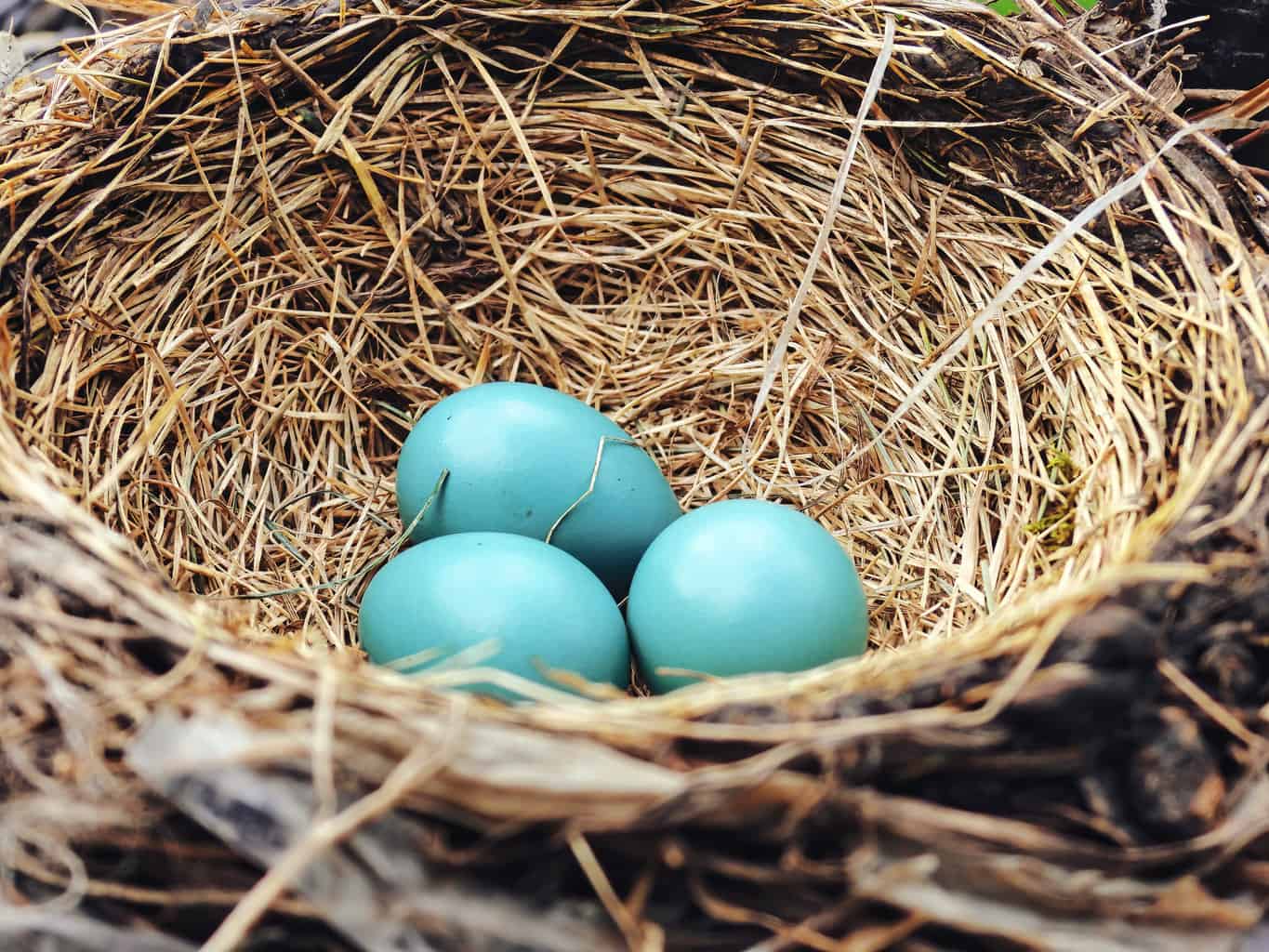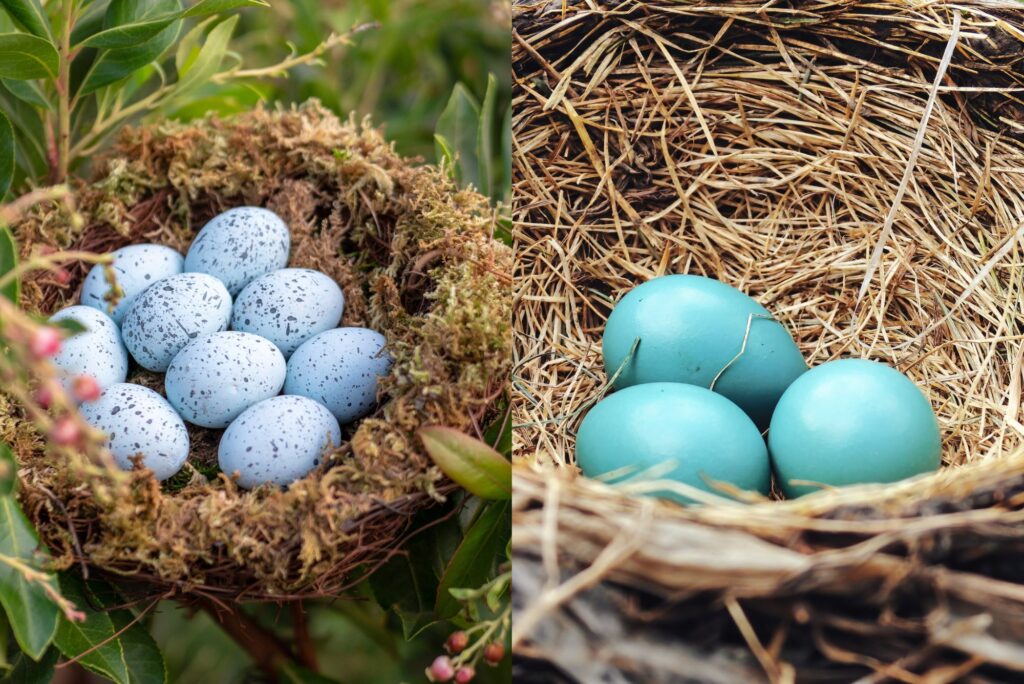I always treasured discovering a little blue robin’s egg in the backyard. These half-shells were small and delicate, and I would keep them in a little jewelry box lined with soft cotton.
Robin’s eggs were the first bird eggs I learned to identify, and I’m sure I’m not alone. For many of us, spotting a robin’s egg adds a little joy to our day!
Sometimes, you’ll find an egg on the ground and be unable to identify it. Is this a robin’s egg? The color seems right, but what about those speckles? Are robins the only birds that lay blue eggs?
Being able to differentiate between a robin’s egg and a blue jay’s egg is a great skill! As a birder, the more we know about the birds we love, the happier we are. Let’s discuss blue jay eggs vs robin eggs…
All About Robin Eggs
Because American robins are one of the most plentiful birds in North America, their eggs are plentiful, too. During the breeding season, a female robin will lay a clutch of 5-6 eggs, each just over an inch long. They lay eggs up to three times a year, so it’s no wonder that robins’ eggs are generally easy to find strewn about under a nest.

Robin’s Egg Appearance
Robins’ eggs are always blue, but there can be some variation in the hue. They can range from pale blue to medium blue. In rare instances, they are so light in coloration that they are almost white. They may be lightly speckled brown.
Robin’s Egg Size
A robin’s egg is quite small. They range from 1.1 to 1.2 inches long and 0.8 inches wide. A good guideline for recognizing robins’ eggs is that they are about the size of a quarter.
Robin’s Egg Nesting & Incubation
The incubation period for a baby robin is 12-14 days. After that, it takes only 13 days for the robins to mature enough to leave the nest.
Why Are Robin Eggs Blue?
The impact of the coloration of robin eggs is quite fascinating!
Research from Queen’s University in 2012 showed, “The blue colour in robin eggs is due to biliverdin, a pigment deposited on the eggshell when the female lays the eggs. There is some evidence that higher biliverdin levels indicate a healthier female and brighter blue eggs. Eggs laid by a healthier female seemed to encourage males to take more interest in their young.”
Are Robins’ Eggs the Only Blue Eggs?
Blue eggs are not uncommon in the world of birds.
Some species of birds that lay blue eggs are:
- Blue jays
- Blue-footed boobies
- Goldfinches
- Red-winged blackbirds
- Starlings
- Snowy egrets
- Dunnocks
- Blue finches
- Great tinamous
These are birds that can be found throughout the world, and many are in North America. If you find a blue egg, you can’t automatically assume it’s a robin’s egg. Confirm that you are in an area where robins live and are currently breeding.
All About Blue Jay Eggs
As another populous bird in the US, Blue jays are the source of many of the other blue eggs you might find in the grass.

Blue jay eggs are slightly larger than robin eggs, which makes sense as blue jay adults are also larger than robins. They can be found underneath a blue jay nest, typically built where the tree branch meets the trunk.
Blue Jay’s Egg Appearance
Blue jay eggs are either blueish in color or light brown. They are speckled with brown or cream-colored spots. They don’t have the same vibrancy of color as a robin’s egg.
Blue Jay’s Egg Size
One thing that can cause confusion between robin and blue jay eggs is that they are both about the same size. Like a robin’s egg, a blue jay’s egg is 1.0-1.3 inches long and 0.7-0.9 inches wide. That means they have the potential to be only 0.1 inches longer and 0.1 inches wider than a robin’s egg. A difference like that is hardly perceptible when you’re trying to identify an egg.
Blue Jay’s Egg Nesting & Incubation
Blue jays incubate longer than robins. They stay in the nest for a longer time, too. Blue jay eggs will hatch 17-18 days after being laid in the nest. They will remain in the nest for another 17-21 days.
Interesting Facts About Blue Jay Nests
I love learning about the nesting habits of birds. I think it’s fascinating to see how they live their lives, including how they nest and raise fledglings.
Blue jays make their nests out of roots, small sticks, leaves, moss, and grass and may reinforce them with mud. The female blue jay does most of the building, but the male may assist her.
The blue jay species is already known for being territorial and aggressive toward other birds, but that really ramps up when they have a nest to protect. They may be quiet nest-builders, but they are determined nest-protectors who will chase away anything they consider a threat–including birds, pets, and people!
What To Do If You Find a Nest of Robin or Blue Jay Eggs
If you find a nest of unhatched eggs, the best thing to do is leave it alone. Chances are, the blue jay or robin is nearby. Perhaps it is eating, gathering materials to repair the nest or bathing in a nearby bird bath.
The bird may be afraid to return to the nest if you stay close. Leaving the nest unattended for too long can leave the eggs susceptible to predators or cause them to stop developing. A bird must sit on the eggs to keep the temperature warm enough for hatchlings to develop and thrive.
If, on the other hand, you leave the nest alone and watch from a distance, you will probably see the bird return and take her spot on her eggs.
Once the robin or blue jay returns, you only have a short time to wait for the birds to hatch! Avoid bothering the nest or the hatchlings, and only watch from a distance. Soon, the babies will make their way into the world, and you may be lucky enough to see them on their way!

